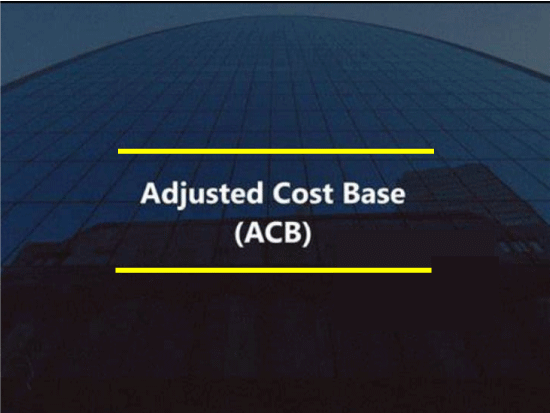Adjusted Cost Base (ACB)The Adjusted Cost Base (ACB) is an important financial metric that tracks an investment's performance. It represents the original cost of an investment, adjusted for some events such as reinvested dividends, return of capital, and other capital transactions. 
This metric is important for different reasons, including calculating the capital gain or loss when an investment is sold, keeping track of the performance of a portfolio, estate planning, and concurrence with regulations. Understanding and keeping accurate records of the ACB is essential for anyone looking to manage their investments effectively. This article will explore the concept of the ACB in more detail, including its importance, how to calculate it, and tips for keeping accurate records. Importance of Tracking ACB for Tax PurposesIt is important to track down the adjusted cost base (ACB) of the investment for tax purposes because it helps determine the capital gain or loss when the investment is sold. Capital gains are calculated by subtracting the investment's ACB from the selling price. It means that the investor will gain capital only when the selling price exceeds the ACB. Capital gains from other investments can balance capital losses from investments if the selling price is less than the ACB. An investor may minimize the taxes imposed on his capital gains if he accurately tracks down the ACB. Also, keeping accurate track of ACB for every investment may help investors make more informed decisions. It should also be noted that in some countries, if the investors do not have proper records of ACB, they are fined or punished for that. How to calculate ACB?The adjusted cost base (ACB) is calculated by adding the original cost of the investment and any other additional costs incurred to acquire or improve. Then, capital return is subtracted from it. The original investment cost is the purchase price and also includes any commissions or fees attached to the purchase. Legal or accounting fees can be included as additional costs in the ACB in order to calculate the final investment. It is very important to keep records of these additional costs as they can increase the ACB. Capital returns like dividends or distributions can also affect the ACB. However, these returns decrease the ACB, as they are a return on the investor's original investment. Therefore, to decrease the ACB, it is important to keep track of these returns, which can affect the capital gain or loss when the investment is sold. Now for the calculation of ACB, one must first add the original investment costs and additional costs and subtract the capital returns from it. For example, suppose an investor buys 100 shares of a stock which costs him $50 per share plus a $10 commission; then ACB would be calculated as $5,010 ($50 x 100 shares + $10 commission). If the investor later receives a return of capital of $500, the ACB would become $4,510 ($5,010 - $500). If the investor then incurs a $50 legal fee to improve the stock, the ACB would be $4,560 ($4,510 + $50). To calculate the ACB when the investment is sold and determine the capital gain or loss, keeping records of all the transactions becomes very important. How does ACB affect Capital Gains Tax?A capital gain or loss is calculated when an investor sells based on its adjusted cost base (ACB). The difference between the investment's selling price and its ACB determines the capital gain. If the selling price is higher than the ACB, the investor will have a capital gain, which is subject to taxes. The investor can offset capital gains from other investments if the selling price is lower than the ACB. For example, if an investor buys 100 shares of a stock for $50 per share, plus a $10 commission, the ACB would be $5,010 ($50 x 100 shares + $10 commission). If the investor later receives a return of capital of $500, the ACB would be adjusted to $4,510 ($5,010 - $500). If the investor sells the shares for $60 per share, the capital gain would be $1,490 ($6,000 - $4,510). This capital gain is subject to taxes. The higher the ACB, the lower the capital gain, and the lower the taxes owed. Investors need to keep accurate records of their ACB to calculate their capital gain or loss and minimize the amount of taxes they owe. The loss of capital can also be offset by the gain in capital in future years, thereby lowering taxes due. Keeping Track of ACBThe phrase "keeping track of ACB" refers to monitoring and documenting an investment's Adjusted Cost Base (ACB). Importance of Accurate Record KeepingFor specific reasons, it is important to keep accurate records of an investment's Adjusted Cost Base (ACB). The ACB is the original cost of an investment, adjusted for certain events such as reinvested dividends, return of capital, and other capital transactions. Let us now look at some notable factors explaining the importance of accurate records and their implications with ACB: 
Tips for Tracking ACBTracking the Adjusted Cost Base (ACB) of an investment can be challenging, but several tips can help to make the process easier:
The Bottom LineIn conclusion, the Adjusted Cost Base (ACB) is a crucial metric for tracking the performance of an investment and for tax compliance. It represents the original cost of an investment, adjusted for certain events such as reinvested dividends, return of capital, and other capital transactions. Keeping accurate records of the ACB is essential for calculating the capital gain or loss when an investment is sold and for monitoring the performance of a portfolio. The ACB also plays an important role in estate planning since the investments will be transferred to the heirs at the ACB, not the current market value. There are several ways to track the ACB, such as using a spreadsheet or software, and it's important to keep all documentation, track reinvested dividends, and regularly review and update the records. It is important to note that the accuracy of the ACB is crucial for tax compliance and avoiding penalties.
Next TopicAED (United Arab Emirates Dirham)
|
 For Videos Join Our Youtube Channel: Join Now
For Videos Join Our Youtube Channel: Join Now
Feedback
- Send your Feedback to [email protected]
Help Others, Please Share









